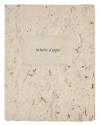The Handrail (La barre d’appui)
Artist: Pablo Picasso (Spanish (active France), 1881-1973)
Publisher: Éditions "Cahiers d’art", Paris, 1936
Printer: etchings: Roger Lacourière, Paris;
text: Aimé Jourde, Paris
Author: Paul Éluard (French, 1895-1952)
Date: 1936
Dimensions:
Book: H: 8 9/16 in. (217 mm); W: 6 5/8 in. (169 mm); Depth: 1/4 in. (7 mm).
Page (untrimmed): H: 8 3/16 in. (208 mm); W: 6 1/4 in. (158 mm).
Platemark: H: 6 1/8 in. (155 mm); W: 4 1/8 in. (105 mm).
Medium: Original prints: 3 mixed etchings.
Text: letterpress (typeface: Garamond Italic).
Paper: buff wove imperial japan paper.
Classification: Books
Credit Line: Gift of Molly and Walter Bareiss in honor of Barbara K. Sutherland and Mrs. George W. Stevens Fund
Object number: 1985.129
Label Text:La Barre d'Appui is considered a gem among Picasso's smaller format illustrated books. Paul Eluard's eight surrealist poems, dedicated to his wife Nusch, were accompanied by three prints executed in the lift-ground etching and aquatint technique Picasso had just learned. The frontispiece was a portrait of Nusch Eluard; the serene image of the sleeping woman, paired with the poem "Le sablier vide," was inspired by Marie-Therese Walter, Picasso's mistress at this time. lA BARRE D'APPUI (The Hand Rail) is one of the most successful of Picasso's smaller books. The year 1936 was one in which Picasso's production was small, so the three etchings in this little volume form an important stylistic record. Like the poetry they illustrate, the plates have a surrealist character. Picasso's Spanish friend Sabartés described the creation of these etchings:"Picasso took a copper plate, divided it into four equal parts by crossing two lines and filled in the first rectangle with a very intricate design. On another he sketched a portrait of Nusch (Eluard), and got rid of the third space by drawing the head of a sleeping woman (Marie-Therese Walter), with a landscape in the background. Since an empty rectangle remained, he daubed the palm of his hand with ink and applied it to the copper. Before cutting the plate in four, eighteen copies of this aquatint were printed bearing the illustrations and a handprint of the artist." (Excerpt from Eleanor M. Garvey, THE ARTIST AND THE BOOK 1860- 1960, cat. no. 227.)
Not on view
In Collection(s)








